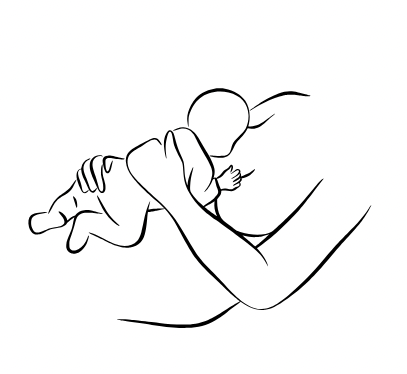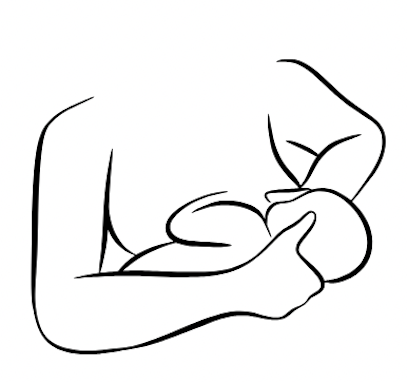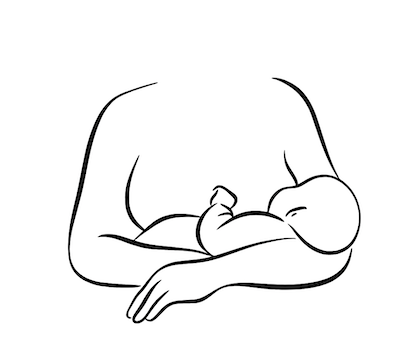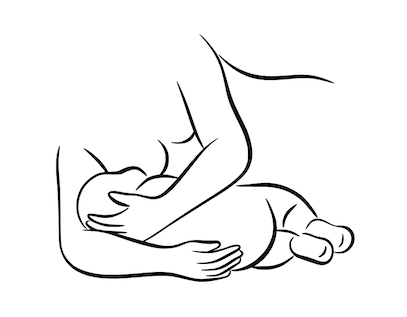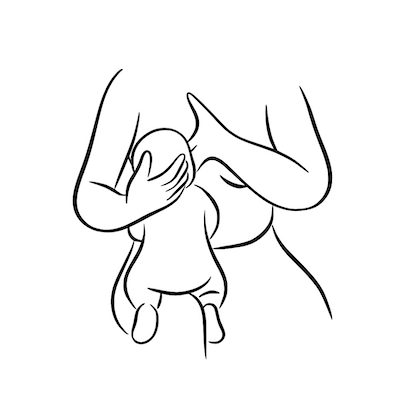Breastfeeding Positions - Which one will work for me?
Prior to highlighting the different breastfeeding positions that you may want to practice and adopt with your baby, I feel it is very important to share a term called - ‘Positional Stability’ with you. ’Positional Stability’ refers to how your baby is held and fits in your arms and against your body in preparation for latch and attachment, and throughout the duration of a feed.
When positional stability is achieved, a baby can comfortably tap into their natural feeding reflexes and behaviours. This in turn helps to promote successful milk transfer to your baby; breast tissue comfort throughout the duration of the feed; and protection of your milk supply and breast health long term.
International Board Certified Lactation Consultants (IBCLC’s) are acutely aware of the term positional stability, as it is one of our primary focuses, and we have a duty of care to you and your baby in being able to provide support and guidance. I like to describe positional stability in all different feeding positions as ‘body - baby - alignment’. In simple terms, the best way to promote positional stability for you and your baby as you prepare to attach and feed together, is to focus on the bolded dot points below:
Babies arms wrapped around either side of your breast (no trapped arm/hand between your chest wall and that of your baby’s)
Chest-to-Chest
Tummy- to-Tummy
Babies bottom cuddled in close
Back supported in alignment with your body with the use of the length of your forearm/arm, wrist and hands. (Positional Stability is achieved naturally in the ‘laid back’ Biological Nurturing Position - ie: simply with the gravity of your baby’s body against yours - when you are both positioned together in a semi-reclined position).
Babies chin and cheeks in equal full contact with your breast tissue
Babies nose in very close, or in contact gently with your breast tissue (allowing the ‘suck-suck-suck- pause - swallow- breathe’ rhythm of feeding to be uninterrupted. ie: baby does not pull off to breathe due to nostrils being occluded by your breast tissue).
Head free to slightly extend without causing any nipple drag discomfort
I am very passionate about supporting families to find breastfeeding positions that are the most comfortable and successful for ‘mum and bub’. My focus as a Lactation Consultant healthcare professional, primarily is to not place focus on any one feeding position being more superior over another feeding position. My practice will always be guided by the feeding parent and their baby. It is all about finding the most comfortable position for the mum and baby together - allowing for excellent milk transfer to baby, overall comfort and enjoyment when feeding. Feeding positions will evolve and adapt as your baby grows, and often can change as your baby reaches different developmental milestones.
Let us dive into and explore 6 different common breastfeeding positions you may want to try with your baby throughout your feeding journey together:
(1) [Biological Nurturing/Feeding]:
This is a wonderful place to start after you have given birth. AKA the ‘Breast Crawl’. ‘Baby-Led Attachment’ and ‘Laid-Back Breastfeeding’ are two further ways this position is described, or you may have heard of. Babies will begin to tap into their instinctual feeding behaviours if they are able to spend uninterrupted skin-to-skin contact with their birthing mother immediately following the baby’s birth. If this is not possible, this can always be reintroduced at another suitable time for mum and baby.
This position can be really wonderful for you and baby for many weeks and months following birth. It could also be the only position you will ever use throughout your breastfeeding journey together.
When baby is placed skin to skin, chest-to-chest, and tummy -to-tummy with you following giving birth, you will notice the following instinctual seeking feeding behaviours:
** Baby’s feet pushing against you to move closer towards the breast (you can support your baby’s feet with your hands if needed, this gives them a landing pad to push from). Your own body, tummy, and thighs can also be a very supportive landing pad for your baby to anchor/push from, and holding their bottom is all that is needed.
** Increase in baby’s saliva, which helps your baby to track towards their preferred breast to attach
** Sucking of fist, and moving head from side to side
** For some babies - Resting and sometimes falling back to sleep, to then awake and recommence seeking feeding behaviours
** Head bobbing towards preferred breast.
** Sometimes gentle manoeuvring of your arms, hands and/or wrists that assist in providing support for your baby throughout the breast crawl can be helpful. Ask for guidance from your midwives caring for you, as they will be very supportive for this to happen. (PS: Great video link below of a mum doing this gentle positional guidance and support with her baby at 4 weeks of age at home).
Regular skin-to-skin with our babies, with us in an awake and relaxed state, feeling supported in a semi-reclined position (as per the drawing above and the video link below), cradling and supporting our babies with our body will always promote your baby’s instinctual seeking and feeding behaviours.
[Please note]: It is also very worthwhile sharing this discussion with your primary health care provider caring for you in pregnancy and birth, that you would like to protect this precious time of uninterrupted skin-to-skin with your baby immediately after giving birth if possible.
** This conversation is very important for families who may need, or are choosing to have a cesarean birth. It is now becoming common practice in many hospitals worldwide, where skin-to-skin with mum in theatre is actively encouraged. It is always worth asking the question, rather than being disappointed if it was possible, but your primary health care providers were not aware of your birthing preferences.
The link below provides a wonderful and close up video of a baby-led attachment with a mum and baby at 4 weeks of age. You can fast forward to - [2:20 minutes ] - to view the attachment. Viewing the whole video will provide you with further understanding of the advantages of biological nurturing feeding position.
(2) [Cross Cradle position]:
Often as we begin learning to feed with our babies (and a BIG yes for learning together), cross cradle is a very common position for you to be encouraged to try as you learn to hold your baby for attachment. If you feel more confident and happy to continue with for example - biological nurturing feeding position, then I encourage you to confidently share this with your support people. It is all about listening to mums preference!.
In dot point below following the positional stability description of ‘body-baby-alignment' as set out above:
** Position yourself comfortably in either bed or sitting on a couch/chair
** Place a cupped open palm (I like to describe it as fingers closely together and thumb straight up), gently either side of your baby’s shoulder blades at the base of their neck, without holding their head. Aim for your baby’s head to be slightly extended, as you yourself would naturally do if you were to drink a glass of water.
** Baby’s back and bottom is supported along the length of your forearm as you cuddle them in close and in alignment with your body.
Then…
** Lead in with your baby’s chin to touch your breast below the base of your nipple - and focus on their lower lip/tongue to attach approximately 3 cms below the base of your nipple. (This naturally positions your nipple opposite their nose, something you may hear often from your support midwives and/or support people).
** Bring your baby to your breast closely in this secure position once your baby is actively rooting for your nipple with a wide open mouth, allowing for a lovely deep attachment.
(3) [Cradle position]:
The cradle position can easily be practised as an adaptation to the cross-cradle hold or independently on its own. The adaptation from cross-cradle is accomplished by bringing your opposite free arm around to replace the open palm arm that you used in the cross cradle attachment sequence.
I like to say to breastfeeding mums - “As you bring your other arm around, you can overlap your supporting arms together, and you can gently wriggle your open palm hand out of place completely, and baby is now supported in the cradle of your other arm - hence Cradle position.
Always aim to minimise moving your baby’s head position, which can be helped by dropping your elbow to your waist as you bring this arm around. This really supports your baby’s head to remain in the slightly extended position needed for positional stability and uninterrupted comfortable feeding for you both. It takes a bit of practice, and once again - you and bub work and learn together to find a happy position for you both.
(4) [Football/Rugby Hold]:
This can be a wonderful position for mum and bub for many reasons. For Mums who do not want any pressure on their abdomen; or for greater visibility of bringing baby to your breast (some women with larger or more pendulous breasts find this position very helpful), or simply just personal preference.
I have supported many feeding mums who have chosen to feed cradle hold on one side and football hold on the other. Whatever works for you and bub is always key!
Following the same principles as above with ‘positional stability’ - I find the football hold in a position that can create as much space as possible behind you is very helpful. What I mean by this as an example - If you are using a comfy seat to position yourself ready to feed - try and create space behind you on the side you are going to attach baby, so baby can feel supported without pushing themselves forward beyond where your breast tissue and nipple naturally fall.
It might help you to imagine this…you are sitting in a comfy chair with space either side of you - and you plan to attach baby on your right breast - point your knees to the left side of the chair (yes on an angle) this creates the space needed for your baby to be moved back easily and in line with access to your breast that doesn’t require you to bring your breast to your baby, always aim for lifting ‘baby-to-breast’. A little stool to support your feet can be helpful too, but not always necessary…always aiming for maximum comfort for you. With a supportive pillow behind your back, and one beside you that you can lean your forearm easily on with baby in your arms that does not raise your baby’s head above or beyond the natural fall of your breast.
(5) [Side lying]:
Great for resting your perineum and bottom if healing from birth is needed. Also a lovely position for you to feed easily and with less disturbance overnight, or for the day time naps if you can fit them in (which I am always a fan of for feeding families). For families who have a side cot attached to their bed, it can be as easy as gently lifting or scooping baby close to you to feed, and then safely returning them to their safe sleeping environment in close proximity to you.
Some mums feel most comfortable with their head supported on their pillow with their lower arm (feeding side) curved in a C shape around their baby, and with their free upper arm, bring baby’s body in close and aligned with theirs, as with all the positions described above. Tucking baby in close side lying with you - can be further supported by either holding their back and bottoms in close with your hand, or by a pillow support. Baby’s head needs to be completely free so they are able to easily detach when they are fully satiated and content.
Lowering your legs from a fully flexed position can help to lower baby’s body down and along your torso to promote leading in with their chin and attaching approximately 3 cms below the base of your nipple. This one can take a little practice, but once mastered can be a really lovely and favourite position to feed in. PS: one of my personal favs. Whatever could promote more sleep as a feeding mum for me was always a win!!!.
(6) [Koala Hold]:
Positional anatomy of mum and baby will come into play quite strongly here, and is a position that can feel fabulous for you and bub together. As you can tell from the picture provided this baby is straddling mums legs and can work well for an older baby. In saying this, it can also be really successful for a younger baby also, as long as the anatomy of mum and bub fit comfortably together. That is, where ‘positional stability’ is maintained, and the need to either raise or lower your breast and nipple to your baby to allow for attachment is avoided. It is important to always bring ‘Baby to Breast’ and not ‘Breast to Baby’.
Please note: for babies with hip dysplasia, or for paediatric review for hip dysplasia follow-up, please discuss this position first with your primary health care provider.
That was a very long Blog post…well done on getting to the end and hope you found this information helpful. You will find what works for you. It takes time and practice, and above all is something you will learn together with your baby.

